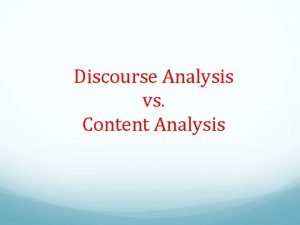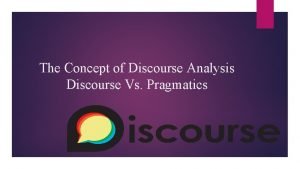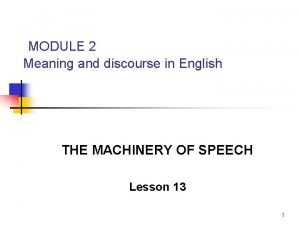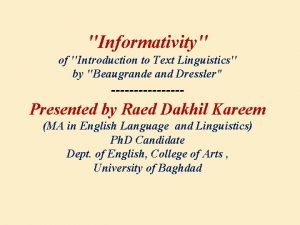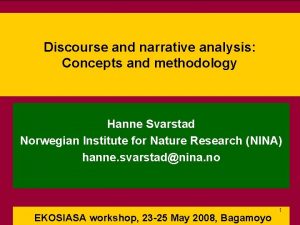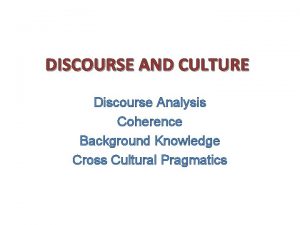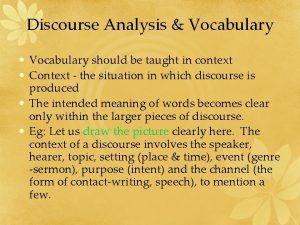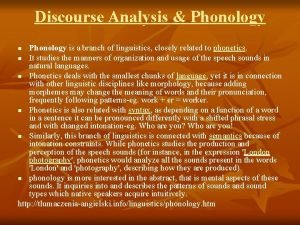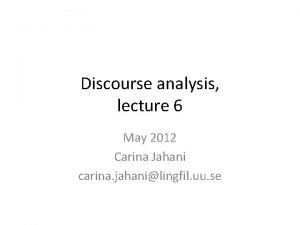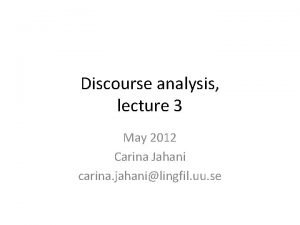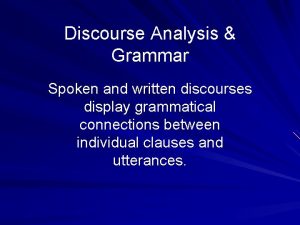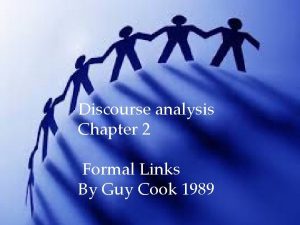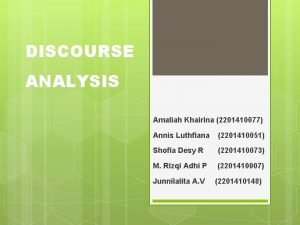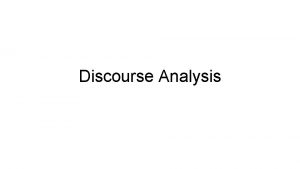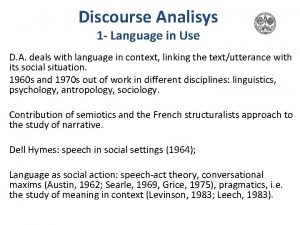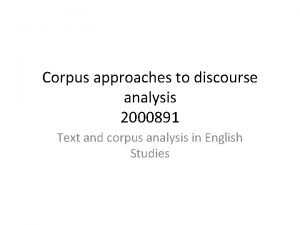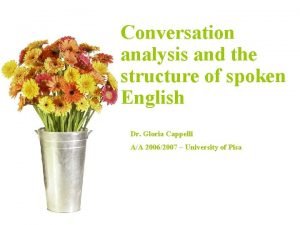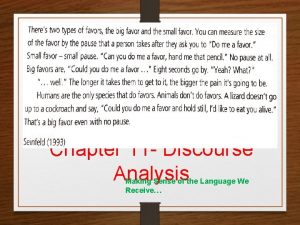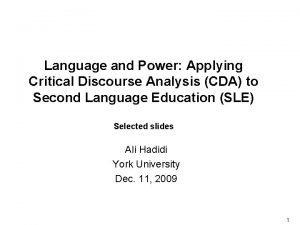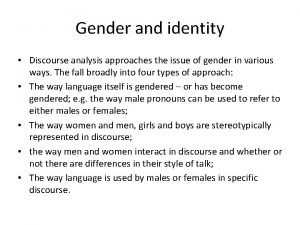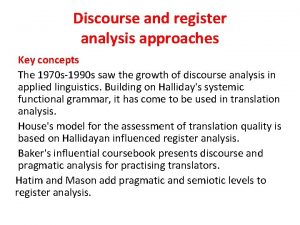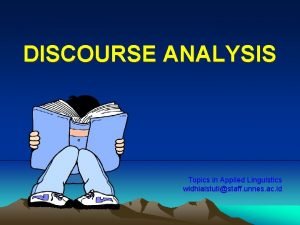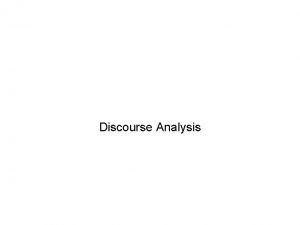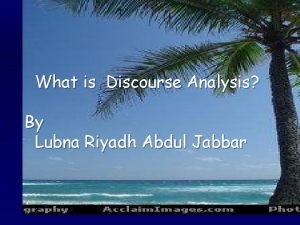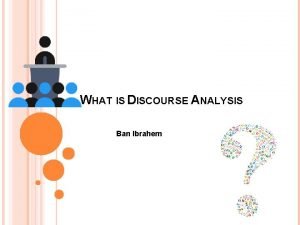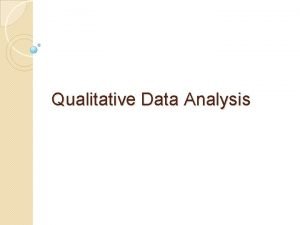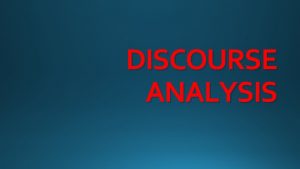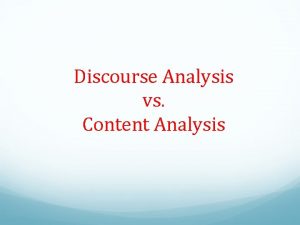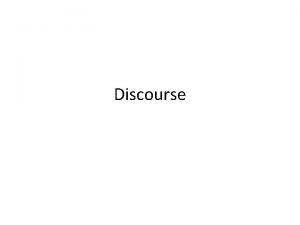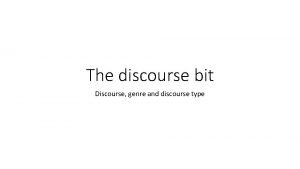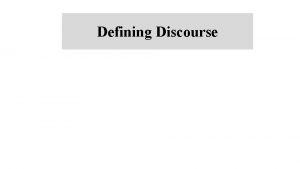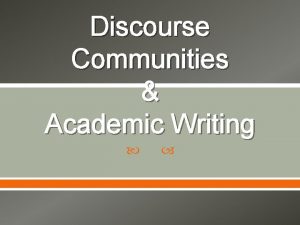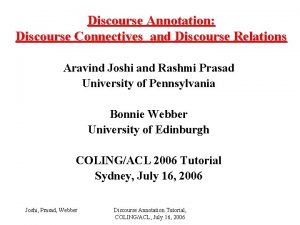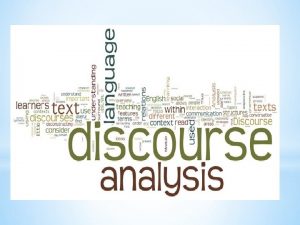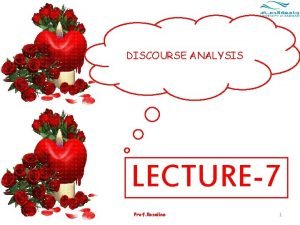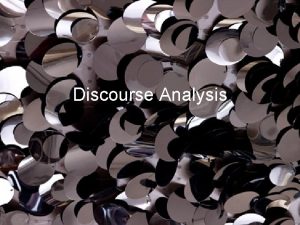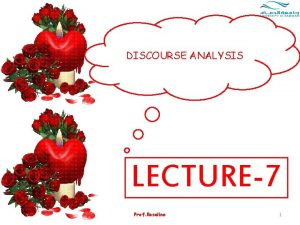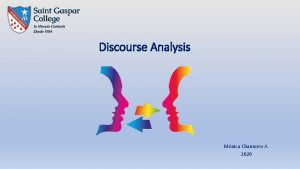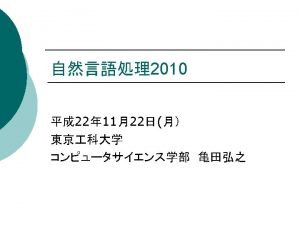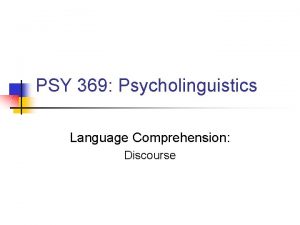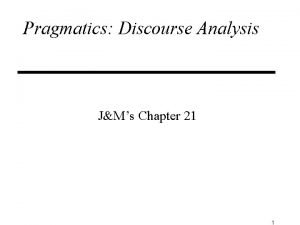DISCOURSE ANALYSIS What is discourse Discourse is language



































- Slides: 35

DISCOURSE ANALYSIS


What is “discourse”? • Discourse is: • language above the sentence or above the clause a continuous stretch of spoken language larger than a sentence, often constituting a coherent unit a stretch of language perceived to be meaningful unified, and purposive; language in use (viewed) as social practice determined by social structures


• • Kridalaksana (1978: 23): dalam konteks tata bahasa, wacana merupakan satuan gramatikal tertinggi atau terbesar. Artinya, wacana itu mencakup kalimat, alinea atau paragraf, penggalan wacana, dan wacana utuh. Djajasudarma (1994: 3): wacana direalisasikan dalam bentuk karangan yang utuh (novel, buku seri ensiklopedia, dan sebagainya), paragraf, kalimat, frasa, bahkan kata yang membawa amanat yang lengkap. Dengan demikian, dapat dikatakan bahwa sebuah wacana dalam realisasinya selalu berupa sekumpulan kalimat. Kalimat dapat dibentuk dari sekumpulan klausa, frasa, kata, morfem, fonem, dan fona. Berkaitan dengan hal itu, bahasa yang digunakan untuk membentuk suatu wacana harus bersifat kohesif dan koheren, atau terjalin erat antara satu dan yang lain, disusun secara teratur dan sistematis di dalam rangkaian kalimat, baik dalam bentuk lisan maupun tulis.

Discourse • Discourse is: ‘language above the sentence level or above the clause. ’ » Stubbs 1998 • The study of discourse is the study of any aspect of language use. » Fasold 1990 • The analysis of discourse is the analysis of language in use…it cannot be restricted to the description of linguistic forms independent of the purposes or functions that they serve in human affairs. » Brown and Yule 1983

Discourse • ‘Discourse’ is for me more than just language in use: It is language use, whether speech or writing, seen as a type of social practice. » Fairclough 1992 • Discourse constitutes the social…Discourse is shaped by relations of power, and invested with ideologies. » Fairclough 1992

PENGERTIAN ANALISIS WACANA 1. Stubbs (dalam Oetomo, 1993: 4) menyatakan bahwa analisis wacana merujuk pada upaya mangkaji pengaturan bahasa di atas kalimat atau klausa 2. Kartomihardjo (1993 : 21) menyatakan bahwa analisis wacana merupakan cabang ilmu bahasa yang dikembangkan untuk menganalisis suatu unit bahasa yang lebih besar daripada kalimat dan lazim disebut wacana Jadi analisis wacana lebih pada suatu pengkajian suatu unit bahasa yang lebih besar daripada kalimat yang juga melibatkan aspek-aspek di luar aspek linguistik yang turut memberi makna terhadap suatu bahasa yang digunakan tersebut. Unit bahasa yang dimaksud bisa berupa paragraf, teks bacaan, undangan, percakapan, cerita pendek, dan sebagainya

* TUJUAN WACANA * Tujuan wacana yaitu (1) menyampaikan informasi, (2) menggugah perasaan, dan (3) gabungan keduanya Ketiga tujuan penuangan wacana itu masing-masing berfungsi informatif, emotif, dan informatif-emotif


PERBEDAAN WACANA DAN TEKS Perhatikan contoh berikut. a. Dilarang berjualan di sini (di papan pengumuman) b. Wah, indah benar lukisan yang dibuat olehnya (dalam dialog) c. Awas ada anjing galak (tulisan di atas pintu pagar) d. Bunga itu kukirimkan padanya (dalam sebuah novel) Di sini tampak bahwa semuanya (a, b, c, dan d) bisa disebut teks, tetapi hanya (a) dan (c) saja yang bisa disebut wacana, karena (b) dan (d) tidak menunjukkan satuan makna yang jelas. Bila diperhatikan, “nya” dalam kalimat (b) dan “ku” dan “nya” dalam kalimat (d) tidak memberi makna 11 sepenuhnya.

Lanjutan…. . Meskipun hanya terdiri dari satu kata, tulisan toilet di pintu, sudah dapat dikatakan sebagai wacana, karena dengan bantuan pengujarannya (situasi komunikasinya), kata itu sudah komunikatif. Sudah membawakan pesan yang jelas. Demikian pula kata masuk dan keluar di atas sebuah pintu, sudah dapat dikatakan wacana.

Intertextuality • “… the meanings of any one discursive image or text depend not only on that one image or text, but also on meanings carried by other images and texts. ” • e. g. , pictures of prostitutes in Rose.

• Van Dijk (1997): wacana menyangkut penggunaan yang lebih luas: siapa, bagaimana, mengapa, dan kapan menggunakannya. • Schiffrin (1997) menyarankan beberapata pendekatan ntuk memahami penggunaan Bahasa dalam konteks tersebut:

• • • 1. 2. 3. 4. 5. 6. Teori Tindak Tutur (Searle) Sociolinguistik Interaksional Etnografi Komunikasi Pragmatik (Grice) Analisis Percakapan Analisis Variasi

Contoh: • KAPAN LAGI. COM Sticker di angkot diganti menjadi “Kapan lagi Om? ” Pembacaan lisan ini akan membuat otak bekerja mengkonstruk sebuah wacana yang sangat “ luar biasa” bedanya.

Contoh: • “Are you taking a bath? ” Penuturnya orang jawa, kepada penutur Bahasa Inggris. Tujuan: -maintaining social relationship. -greeting “Where are you going? ” = “greeting” ini Javanese culture

Contoh • Anak: Ma, boleh tidak saya besok malam tidur di rumah teman? Mau mengerjakan tugas bareng. • Ibu: Terserah

Contoh • “Jangan kencing disini” • “Dilarang buang sampah disini” PERLUNYA PERAN KOMPETENSI WACANA dalam MEMITIGASI KONFLIK

• All discourse is multimodal, that is, language in use, whether this is the form of spoken language or text, is always and inevitably constructed across multiple modes of communication, including speech and gesture not just in spoken language but through such “contextual” phenomena as the use of the physical spaces in which we carry out our discursive actions or the design, paper, and typography of the documents within which our texts presented. (Levine and Scollon 2004)

Definition of Discourse – written and spoken Speaker/ writer Hearer/ reader Discourse Context

Discourse is… • How language reflects reality • How language creates reality • How language shapes our identities and interactions • How language is used as to tool to control people

• Interaksi anatara dua pecakap terkadang megalami masalah manakala 2 pecakap tersebut memiliki latar belakang budaya berbeda (tidak memilki shared background knowledge yang sama)



What is the meaning of this sentence?

Meaning depends on… • • • How Where When To whom Why

Discourse Analysis Multimodal Discourse Analysis Critical Discourse Analysis Ethnography Of Speaking Mediated Discourse Analysis Conversation Analysis Genre Analysis Pragmatics

Contoh: • Dialog dan Konflik: Lihat Contoh • Komponen dari communicative competence: 1. Grammatical Competence: vocab, pepbentukan kata dan kalimat, pengucapan, ejaan, semantic linguistik, 2. Sociolinguistic Competence: aturan sosiokultural penggunaan bahasa (status pelibat, tujuan interaksi, norma 3. Discourse Competence: kemampuan mengkombinasikan bentuk grammar dan makna dalam teks tulis dan lisan

Speech Acts • Austin (1962) – An utterance in dialogue is an ACTION – Speech acts • Performative sentences uttered by an authority (they change the state of the world) – Any sentence in real speech contains • • • Locutionary act Illocutionary act Perlocutionary act – utterance with particular meaning – asking, answering, promising, etc. – effect upon feelings, thoughts, etc.

Speech Acts • Searle (1975) – All speech acts classified as • • • Assertives Directives Commissives Expressives Declarations – suggesting, boasting, concluding, etc. – asking, ordering, inviting, etc. – promising, planning, vowing, etc. – thanking, apologizing, deploring, etc. – performatives (state-changing)

Pragmatics • Based primarily on the ideas of Paul Grice: • People interact having minimal assumptions (implicatures) about one another; • Two types of implicatures: conventional and conversational; • Conventional implicatures do not require any particular context in order to be understood (or inferred); • Conversational implicatures are context – dependant. What is implied varies according to the context of an utterance.

Pragmatics • To explain HOW we interpret implicatures Grice introduced the Cooperative Principal: • Make your contribution such as required, at the stage at which it occurs, by the accepted purpose or direction of the talk exchange in which you are engaged.

Pragmatics • There are four conversational maxims which help us to realize the implicit meaning if an utterance: • Maxim of Quantity: Make your contributions as informative as required (for the current purposes of the exchange). Do not make your contribution more informative than required. • Maxim of Quality: Do not say what you believe to be false. Do not say something if you lack adequate evidence.

Pragmatics • Maxim of Relation: Be relative. • Maxim of Manner: Be perspicuous (or express your ideas clearly) Avoid obscurity of expressions (= do not use expressions which are not clear or easy to understand); Avoid ambiguity (= presence of more than one meaning); Be brief (avoid unnecessary usage of too many words); Be orderly.
 Discourse analysis in linguistics
Discourse analysis in linguistics Content discourse analysis
Content discourse analysis The role of context in discourse analysis slideshare
The role of context in discourse analysis slideshare Discourse analysis and pragmatics
Discourse analysis and pragmatics Module 2 meaning
Module 2 meaning Informativity in discourse analysis
Informativity in discourse analysis Discourse analysis
Discourse analysis Background knowledge context
Background knowledge context Register and signaling vocabulary
Register and signaling vocabulary Discourse analysis definition
Discourse analysis definition Discourse analysis and phonology
Discourse analysis and phonology Discourse deixis examples
Discourse deixis examples Foregrounding and backgrounding in discourse analysis
Foregrounding and backgrounding in discourse analysis Written and spoken discourse
Written and spoken discourse Formal links in discourse analysis
Formal links in discourse analysis Discours analysis
Discours analysis Buy nlu
Buy nlu Field tenor mode examples
Field tenor mode examples Corpus approaches to discourse analysis
Corpus approaches to discourse analysis Insertion sequence in conversation analysis
Insertion sequence in conversation analysis Making sense of discourse analysis
Making sense of discourse analysis Modes of discourse
Modes of discourse Three days of the condor cda
Three days of the condor cda Gender discourse analysis
Gender discourse analysis Mode of discourse in register
Mode of discourse in register Content and discourse analysis
Content and discourse analysis Discourse organizing words
Discourse organizing words Language
Language Schema and script in discourse analysis
Schema and script in discourse analysis Discours analysis
Discours analysis Discourse analysis in linguistics
Discourse analysis in linguistics What is discourse
What is discourse Types of discourse
Types of discourse What is discourse analysis
What is discourse analysis What is critical discourse analysis
What is critical discourse analysis What is deductive coding
What is deductive coding

